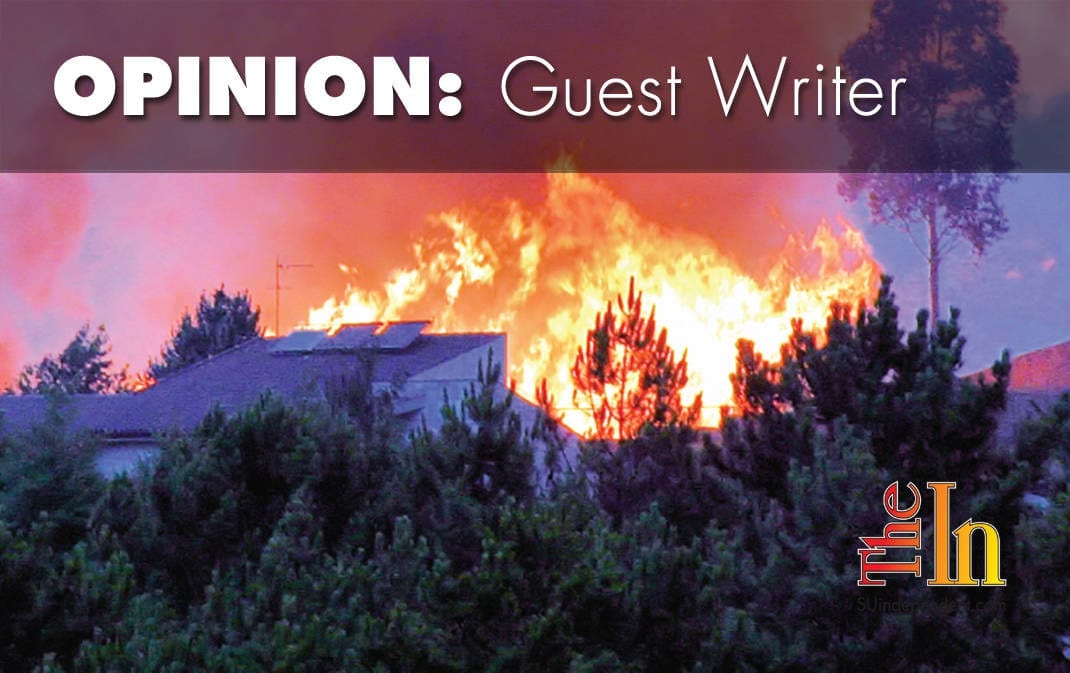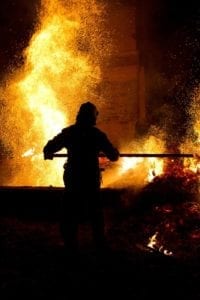
By Michael Kuhns
The recent tragic loss of more than 550,000 acres of forest and thousands of homes in Fort McMurray, Alberta, Canada, brings into focus the hazards that come with wildfire and its suppression and the risks firefighters take to protect life and property. They are tasked with protecting the growing number of structures between wildland and urban environments. Property owners can assist firefighters and improve their own safety by preparing their structures and landscaping for the possibility of a wildfire.
The likelihood of a home burning is directly related to the amount of flammable material near it. The home and landscape near it are called the “home ignition zone.” A few hours of light-duty yard work are well worth the effort to protect this area. To protect your home from fire through landscaping, consider the following tips.
Replace wood roofs with fire-resistant roofing material. Enclose the eaves with soffits and screen openings with 1/8″ galvanized mesh. This will reduce the chances that blowing embers could start a fire in an attic space.
 During a fire, burning embers land in some of the same places that collect leaves, needles, and other debris, so it is important to regularly clear debris from roof valleys, gutters, and deck corners.
During a fire, burning embers land in some of the same places that collect leaves, needles, and other debris, so it is important to regularly clear debris from roof valleys, gutters, and deck corners.
Remove debris from the yard and mow, irrigate, and prune. The first 3 to 5 feet from the home should be a no-burn zone consisting of pavers, concrete, or small, succulent plants. This is a good place for a sidewalk, patio, or driveway to butt up against the house. From there to approximately 60 feet out is the most critical area of the landscape where trees should be thinned and pruned with no shrubs underneath to carry fire into their crowns. This mid-zone should be your irrigated landscape. Mowed, green grass works well, along with manicured beds of herbaceous perennials. Maintenance is key here; a plant that is maintained may be firewise, while one that is not may be a hazard. From 60 to 100 feet out, the landscape should be clean and green with dead leaves, needles, and twigs removed. There should be few trees and shrubs in this zone, and trees should be pruned. To be effective, maintenance must be done on a regular basis, depending on the type and amount of vegetation.
Select appropriate species to grow in the home ignition zone. Evergreens and scrub oaks tend to be highly flammable while aspen and most broad-leaved trees and shrubs are less flammable. Plants that are green and moist during the hottest, driest part of the year are best.
The wildlands beyond 100 feet should be thinned, and brush should not be dumped there. Many people do not control the land 100 feet or more from their home, but a plan can still be in place. Contact your neighbors, and talk with them about safety and what you can do together. This includes individual neighbors but may also include government neighbors like the U.S. Forest Service or the Bureau of Land Management.
Keep firewood, construction material, and other flammable items at least 30 feet from your home. Be sure that propane tanks are located at least 100 feet from any structure, and clear vegetation 10 feet around them.
 Make sure emergency personnel can easily locate and identify your home. Be sure house numbers are clearly marked and visible.
Make sure emergency personnel can easily locate and identify your home. Be sure house numbers are clearly marked and visible.
Your driveway needs to be wide and clear so firefighters can enter it in an emergency. They will need enough overhead and turnaround space to get in and out with equipment.
Take the time to protect your home. Homes that do not meet these minimum specifications are less likely to receive full consideration by firefighters since they pose an unnecessary risk to their safety and equipment.
For a list of firewise plants and more information on landscaping to minimize fire hazard, visit USU Extension forestry’s website at forestry.usu.edu, or call (435) 797-4056.
Michael Kuhns is a USU Extension forestry specialist.






